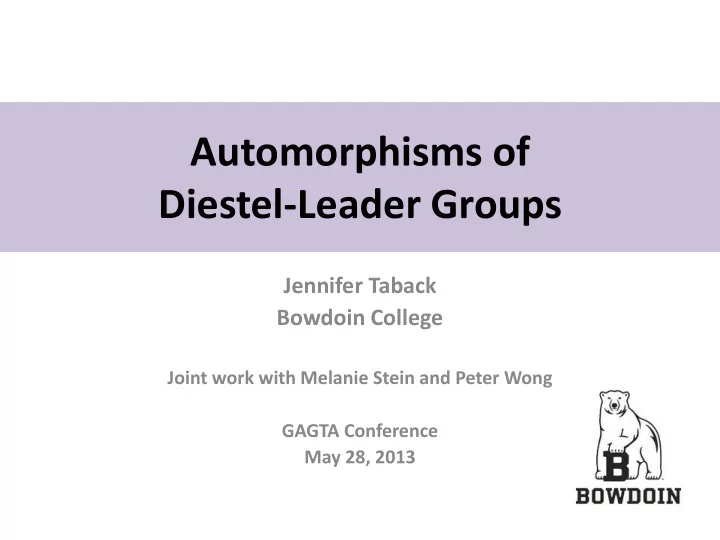

Automorphisms of Diestel-Leader Groups Jennifer Taback Bowdoin College Joint work with Melanie Stein and Peter Wong GAGTA Conference May 28, 2013
Diestel-Leader Groups We define the Diestel-Leader group Γ 𝑒 (𝑟) and generating set 𝑇 𝑒 (𝑟) so that the resulting Cayley graph is the Diestel-Leader graph 𝐸𝑀 𝑒 𝑟 : 𝐸𝑀 𝑒 𝑟 ⊆ 𝑈 1 × 𝑈 2 × ⋯ × 𝑈 𝑒−1 × 𝑈 𝑒 t+ 𝑚 1 t+ 𝑚 2 t+ 𝑚 𝑒−1 𝑢 −1 Formal Variables: ∗ . Where the 𝑚 𝑗 ∈ 𝑎 𝑟 are chosen so that 𝑚 𝑗 − 𝑚 𝑘 ∈ 𝑎 𝑟 ±1 ±1 and ( t+ 𝑚 𝑗 )( t+ 𝑚 𝑘 ) −1 Generating set 𝑇 𝑒 𝑟 : t+ 𝑚 𝑗 𝑐 −𝑐( t+ 𝑚 𝑘 ) 0 1 0 1 where b ∈ 𝑎 𝑟 . This construction of the groups Γ 𝑒 (𝑟) is due to Bartholdi, Neuhauser and Woess and requires that if p is any prime divisor of q, then d ≤ p+1.
Diestel-Leader Groups A generic element of Γ 𝑒 (𝑟) has the form 𝑒−1 (𝑢 + 𝑚 𝑗 ) 𝑓 𝑗 g= 𝑄 𝑗=1 1 0 where 𝑓 𝑗 ∈ Z and P is a polynomial in 𝑎 𝑟 [(t + 𝑚 1 ) −1 , 𝑢 + 𝑚 2 −1 , ⋯ ,( t + 𝑚 𝑒−1 ) −1 , 𝑢 ]. Decomposition Lemma: Let g ∈ Γ 𝑒 (𝑟) be as above. Then P can be written uniquely as P= 𝑄 1 + 𝑄 2 + ⋯ + 𝑄 𝑒−1 + 𝑄 𝑒 𝑄 𝑒 is a polynomial in 𝑢 −1 with only 𝑄 𝑗 is a polynomial in t+ 𝑚 𝑗 with only negative degree terms. terms of non-positive degree. Rough idea of identification between g and a vertex in 𝐸𝑀 𝑒 (𝑟) : ( 𝑓 1 , 𝑓 2 , ⋯ , 𝑓 𝑒−1 ) and P= 𝑄 1 + 𝑄 2 + ⋯ + 𝑄 𝑒−1 + 𝑄 𝑒 determine the vertex in 𝐸𝑀 𝑒 𝑟 corresponding to g.
Algebraic comparison to Lamplighter groups Lamplighter group: 𝑀 𝑜 = 𝑎 𝑜 ∫ Z = < a,t | 𝑏 𝑜 =1, [ 𝑏 𝑢 𝑗 , 𝑏 𝑢 𝑘 ]=1,i,j ∈ 𝑎 > Elements of Ln are often represented by a finite number of illuminated “bulbs” along with an integral position of the “lamplighter.” Positions of the lamplighter Configurations of illuminated bulbs
Algebraic comparison to Lamplighter groups Diestel-Leader groups Abelianization: Commutator subgroup: Positions of “lamplighter,” Configurations of “bulbs,” Coordinates represent the heights Vertices have all coordinates at height 0 In the first d-1 trees; height in the in all d-1 trees last tree is determined. Here L is the analog of the infinite string of “lamps” and is the union of d-1 rays in 𝑎 𝑒−1 .
Automorphisms of Diestel-Leader groups
Induced automorphisms on the quotient
Proof that induced automorphisms of the quotient are permutation matrices
Proof that induced automorphisms of the quotient are permutation matrices Upper right entry Upper right entry is l_j-l_i Is a big mess! Denote it by S-T. Question: What is 𝑄 𝑒 ?
Proof that induced automorphisms of the quotient are permutation matrices
Understanding the commutator subgroup Γ 𝑒 (𝑟)′
The commutator subgroup of Γ 𝑒 (𝑟) In general, the commutator subgroup of Γ 𝑒 𝑟 is defined by View as indexing conjugates of 𝑓 𝑗 1 1 1 by products of 𝑢 + 𝑚 𝑗 0 0 0 1 where K is generated by simply polynomial relations between the formal Variables of the form:
Further restriction of induced automorphisms of 𝑎 𝑒−1 Defining relations of the kernel From the split short exact sequence we see that if then Suppose that φ corresponds to a permutation in Σ 𝑒 which contains the cycle (1 2 3 ⋯ 𝑙). Then φ transforms the relations 𝐿 1,2 , 𝐿 2,3 , ⋯ , 𝐿 𝑙,1 into a system of equations which has a solution iff k=d-1=q is prime. ∎
Counting twisted conjugacy classes in Γ 𝑒 (q) If ϕ =Id then this is regular conjugacy.
Counting twisted conjugacy classes in Γ 𝑒 (q) If ϕ =Id then this is regular conjugacy. 2 is SMALL! d ≥ 𝟒 𝒋𝒕 𝑴𝑩𝑺𝑯𝑭 𝑺 !
Counting twisted conjugacy classes in Γ 𝑒 (q) The one diagram proof… When φ is a permutation matrix it is easy to show that R( φ )= ∞ and hence that R( ϕ )= ∞. When d=3 and q=2 we can verify this directly for the 4 remaining matrices.
Recommend
More recommend